|
History
The original and smaller complex of the Vallombrosans, a Benedictine order created by
a Florentine nobleman called Giovanni Gualberto (see The Story of
Giovanni Gualberto
below), was founded in 1092 on the site of an earlier Carolingian
oratory which they enlarged at this date. Parish church status was granted in 1178, with rebuilding and
expansion following after 1250 in a Gothic style by Niccolò Pisano. Damage
resulting from the flood of 1333 resulted in more work from 1340,
possibly under the direction of Neri di Fioravante. This is the gothic interior
we see today.
A controversial 'restoration to its original form' in the 1890s led to the
loss of mannerist elements, including a staircase in front of the high
altar by Buontalenti of 1574 which is
now in
Santo Stefano al Ponte and said to have been inspired by shells
and bats' wings. This staircase was admired by Francesco Bocchi, writing
in 1591, especially for it's bringing the clergy closer to the
congregation. He also said that the church responds to the eye with
considerable grace despite being planned at a very uncouth time.
Façade
A Mannerist façade by Bernardo Buontalenti from
c.1593. His need for a looming vertical effect leads to his not
covering the whole width with his façade, leaving the odd
diamond-pointed bit to the left, visible in the photo (right).
Interior
A big dark church, even on bright days, and very wide with unusually
wide aisles. Many fine altarpieces, patches of fresco and fully-frescoed chapels - there are
also frescoes or fragments in the arches over most of
the chapels, mostly lost in gloom. The façade of the old, Romanesque, church can be seen
on the inner facade.
The chapels all have semi-hidden boxes with red buttons to push for lighting, and most
of them work, but you'll need a 50 cent or €1 coin to illuminate the Sassetti Chapel.
The left-hand side
The first chapel has minor 17th-century art,
including Saint Lucy (to whom this chapel is dedicated) about to get her eyes gouged out,
by Pompeo Caccini.
In the second chapel
there's a serene Saint Jerome, in an attractive
wilderness with his dozing lion, by Ghirlandaio's son Ridolfo. Like all
the works in this chapel it's the wrong size for it's stone frame.
The third chapel has a fine Annunciation
altarpiece of 1430 by Bicci di Lorenzo. In the left wall here a classical tomb,
of Giuliano Davanzati, with
a small Virgin and Child panel above attributed to Donatello,
restored in 2014. Some good 14th- century 'school of Gaddi' fresco fragments here too.
The fourth chapel, the Compagni family chapel, was
dedicated to Saint John Gualberto. Giovanni Gualberto with Saints (see detail
far below) is a rare, and large, fresco
by Neri di Bicci from 1455, detached from the cloister of the former monastery
of the church of
San Pancrazio after the flood in 1966 and restored and
transferred here.
It has recently been more fully restored. There's also a sweet, but ill-lit Annunciation
here by him. This chapel walls were once frescoed with scenes from the
life of the saint. The remaining scenes are high up on the outer arches, and
show The Murder of St John Gualberto’s Brother and St John
Gualberto Forgiving the Assassin. Some sources say they are by Neri
di Bicci and his
father Bicci di Lorenzo, but they have recently been attributed to
Bonaiuto di Giovanni, an associate of Bicci di Lorenzo.
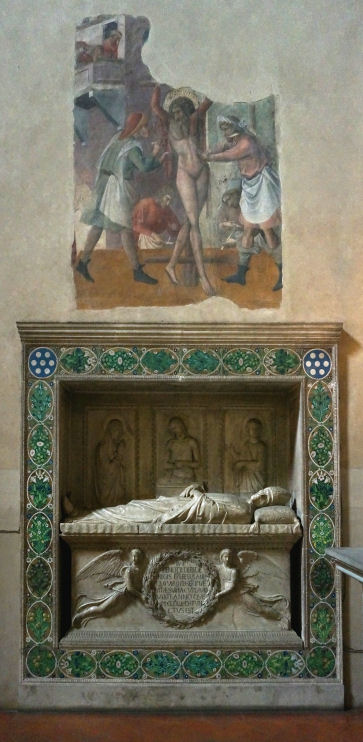 The
fifth chapel is the Chapel of the Assumption, or the Spini Chapel. In
1452/3 Bicci di Lorenzo's son, Neri di Bicci, frescoed this chapel with
scenes from the life of Saint John Gualberto, and in 1455/6 he painted an
altarpiece of The Assumption, now in Ottowa. See
Lost art below. The
fifth chapel is the Chapel of the Assumption, or the Spini Chapel. In
1452/3 Bicci di Lorenzo's son, Neri di Bicci, frescoed this chapel with
scenes from the life of Saint John Gualberto, and in 1455/6 he painted an
altarpiece of The Assumption, now in Ottowa. See
Lost art below.
Apse end
At the end of left transept arm is a small
chapel with lots of marble decoration and fresco decoration by Domenico
Cresti Il Passignano from 1593.
On the left wall of the first chapel on the left is
the lush marble and glazed terracotta tomb of Benozzo Federighi,
Bishop of Fiesole, with a lovely flowery frame, by Luca della Robbia (see
right) from 1454-57. It
came here from the deconsecrated church of
San Pancrazio in 1896.
A monochrome platsre cast of it, from 1888, is in the cast court of the
Victoria and Albert museum in London. Above it
and opposite are tantalising fragments of frescoes of martyrdoms (a flaying
and a beheading?) by
Giovanni dal Ponte.
The next chapel (there's a rocker light switch
to the left, but the attendant will tell you off if you turn it on) is dark and baroque with
17th-century works, including a darkened San Pietro sulle Acqua of
1621 by Cristoforo Allori and Zanobi Rossi
In the baroque choir the high altarpiece
polyptych is a Trinity and Saints Anthony, Michael, Francis, and Julian by Marriotto di Nardo (1424) and you
can get behind it and look at the panels and construction. There is also
a rare surviving 15th-century carved Trinity on the altar below. Similar
images were considered blasphemous by Pope Urban VIII and he ordered
them destroyed in 1628. The apse ceiling disappears into the gloom,
unfortunately, making it hard to see the figures of David, Abraham,
Moses and Noah by Alesso Baldovinetti from c.1470, around the
same time as he painted the Trinity mentioned in
Lost art below.
The next chapel, the Doni chapel, decorated
1608-40 by Ludovico Cigoli, is dark and fenced off, with a painted
Crucifix and grills each side. The Crucifix is the one from
San Miniato which is said to have nodded to Giovanni
Gualberti (see The Story of Giovanni Gualberto below ). It came here
in a procession in November 1671.
The Sassetti Chapel
The last chapel on the right hand side is The Sassetti Chapel with Domenico
Ghirlandaio's very wonderful frescoes of the Life of Saint Francis
from 1483-5. Francesco Sassetti was another Medici bank employee, like
Giovanni Tournabuoni who later commissioned Ghirlandaio to fresco his
larger chapel in Santa Maria Novella.
Sassetti was blamed for the bank's declining fortunes just prior to his
death from a stroke in 1490,
The back wall contains the most interesting scenes. The Miracle of Saint
Francis in resuscitating a boy who had fallen from Palazzo Spini was a
late replacement for the originally-planned Apparition at Arles. It
shows the piazza outside this church and is said to allude to the death of Sassetti's first son Teodoro and the birth of his second, given the same
name as a sort of resurrection. The women clustering to the
left said to be Sassetti's daughters. The figure far right, with his hand
on his hip, is said to be Ghirlandaio. It is said that the whole cycle
contains approaching sixty of Sassetti's family and friends.
The Confirmation of the Rule
scene above (see photo right) depicts a scene which took place in
1223, when Pope Honorius III confirmed the rule of Saint Francis, but it
takes place witnessed by contemporary Florentines against the backdrop of the Piazza della Signoria.
Sassetti stands on the right, between his son Teodoro and Lorenzo de' Medici,
his employer. The forth, furthest, figure in this group is Antonio di
Puccio Pucci, another Medici ally. Lorenzo's sons are led up a staircase
in the foreground by their
tutor Angelo Poliziano. Three more of Sassetti's sons are seen in red on
the left.
Despite
the Florentine settings of these two scenes they both took place in Rome.
The
four
Sibyls in the vaults, including one modelled on Sassetti's daughter
Sibilla, are also by Ghirlandaio, as is the Vision of Augustus and the Tiburtine
Sibyl on the wall above the chapel entrance (see photo above right).
Francesco Sassetti, a Medici banker and his wife Nera Corsi
kneel either side of an equally gorgeous altarpiece, also by
Ghirlandaio, depicting The Adoration of the Shepherds. This
altarpiece is often cited as the work most
obviously inspired by the Portinari Altarpiece (amongst many such)
especially the shepherds. Ghirlandaio depicted himself,
as the shepherd pointing to the Baby and the carved garland (ghirlanda)
on a sarcophagus. The unusual presence of this antique sarcophagus in a
nativity has been explained as it's thereby making a group of three with
the actual tombs of the donors flanking the altarpiece in the side walls.
The right-hand side
The first chapel is firmly fenced in so
the Cenni di Francesco fresco of the Communion of Mary Magdalene
and its sketch opposite, are not easily seen.
The second, quite bare, chapel has a Prediction of John the
Baptist by Francesco Curradi from 1649.
The third chapel has a Neri di Bicci altarpiece of
1466 of The Virgin Enthroned with Saints painted for the church of
Saint Jerome in Fiesole and transferred here in the 19th century. Also in here is a damaged detached fresco
of the Virgin Enthroned with Saints by Spinello
Aretino, with its sinopia opposite which was found under Lorenzo Monaco's
frescoes in the Salimbeni chapel, and still showing his hammer marks.
The fourth, Bartolini Salimbeni Chapel, has frescoes of The
Life of the Virgin and The Founding of Santa Maria Maggiore (1420-25), with the prophets David, Isaiah,
Malachi and Micah in the vaults, mature works by Lorenzo Monaco. These are
his only known work in fresco and almost as
special as the Ghirlandaios. For me the highlights are the people on the
right wall and the architecture on the left wall. The fine c.1420 Annunciation altarpiece,
which fits in with the Life of the Virgin fresco sequence, is also
by Lorenzo (see photo right) who did much good work, especially in illumination, at the convent of
Santa Maria degli Angeli,
but it is in this chapel where you can see his best work in its original
context.
Update 2025/26 This altarpiece has seen recent restoration and is
in the Angelico exhibition at the Palazzo Strozzi until January 2026.
The floor features poppies, the family emblem, and 'Per non dormire' their
motto, which translates as 'For those who don't sleep.'
The fifth chapel is the Ardinghelli chapel, frescoed by Giovanni di
Francesco Toscani, with his brother Domenico, with stories of the life of
Saint Nicholas. A polyptych, Toscani's only documented panel painting,
was also commissioned for this chapel in 1423 for the marriage of Piero di
Neri Ardinghelli to Caterina, the granddaughter of Palla Strozzi. It was
dismembered in the late-18th century (see Lost art
below).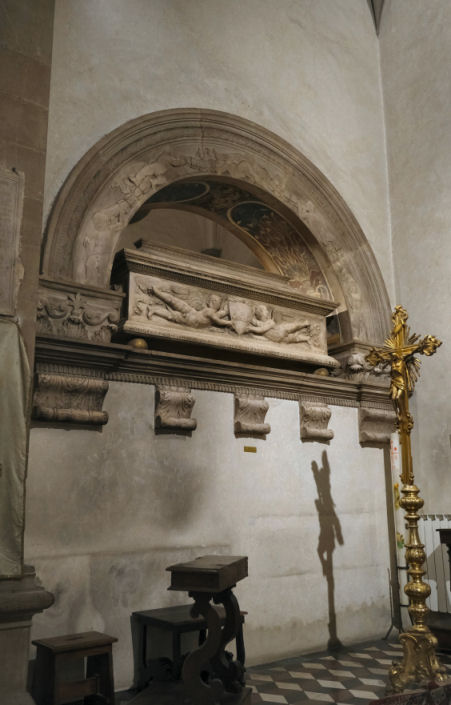
The sacristy
The entrance doorway (by Lorenzo Ghiberti) is to the left of the
side door in the right transept, and is opened on request by the
attendant. It's a pleasingly tall space, which became the Strozzi
family sepulchral chapel in the early 1440s, finished in 1421, and may also have been designed by Ghiberti. It's pretty bare, but there are some detached frescoes, and the tomb of Onofrio
(Nofri)
Strozzi (see photo right) which divides the two rooms here. It was
also built to designs by Ghiberti, commissioned by
his son Palla, who was banished after the revolt in 1434 against Cosimo il
Vecchio. Palla was one of 500 who were banished, and he died in Padua. The
tomb is decorated with flowers painted by Gentile da Fabriano, who also
painted the Adoration of the Magi (now in the Uffizi, see below) for Palla
Strozzi for this
chapel. Aside from a sacristy and family chapel it also served as the
monks' night choir.
The crypt
The entrance staircase is in the centre of the nave. It's a bare and wide and roughly
cross-shaped space (see right), atmospheric if not pretty, and you'll need
a 50¢ coin to light it.
Lost art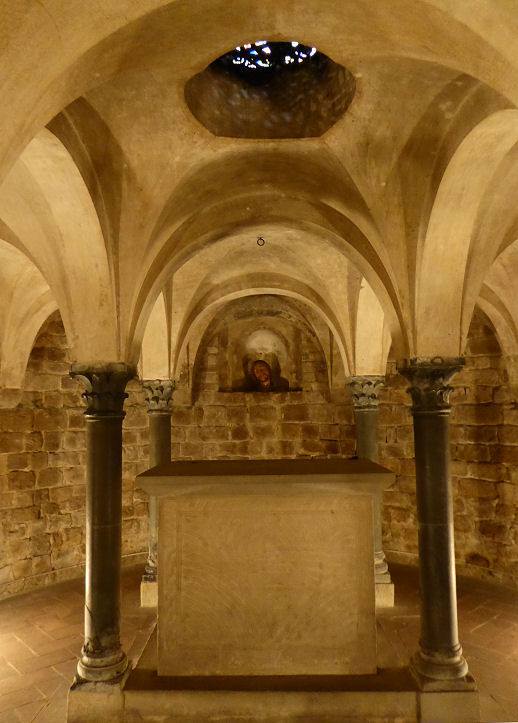
The
Cimabue Maestà (see right)
painted around 1280 for the high altar here. It was replaced with a
Trinity by Alesso Baldovinetti (mentioned below) in 1471 and moved
into a side chapel and later the monastery infirmary. It's been in the
Uffizi since 1919, where it's part of the spectacular Cimabue/Duccio/Giotto trio on display
in room 2.
A polyptych by Giovanni Toscani,
his only documented panel painting, was commissioned for the Ardinghelli
chapel here in 1423/24 for the marriage of Piero di Neri Ardinghelli to Caterina,
the niece of Palla Strozzi. It was split up in the late-18th
century - four panels are in the Accademia, two pinnacles depicting The
Annunciation having been acquired in October 2021. The central
pinnacle of The Crucifixion, has been in the Accademia since 1855.
and one of the panels of the predella, showing both The Stigmatisation of Saint
Francis and Saint Nicholas of Bari Saves a Sinking Ship, they've had since
1933. The remaining panels are in the Philadelphia Museum of Art (the
right section of the predella with The Baptism of Christ and The
Beheading of Saint James the Greater) and the Walters Art Museum in
Baltimore, with the main left-hand side panel and the three tondi
from below the pinnacles still missing. Toscani presented himself as a
painter of cassoni and is believed to have been a pupil of
Giottino.
Update 2025/26 The three panels from this altarpiece from the
Accademia are in the Angelico exhibition at the Palazzo Strozzi until
January 2026.
A magnificent altarpiece signed and dated May 1423 by Gentile da Fabriano,
was commissioned by Palla
Strozzi around 1421 for
the larger of the just-finished family chapels here in the sacristy (see right) over the high
altar where there is now a sculpted Pieta. The gilt and gorgeous central panel, The Adoration of the Magi, and
two panels of the predella, The Nativity and The Flight into
Egypt, are in the original frame in the Uffizi.
It has been asserted that this Adoration is the first time that the
subject was used as the main panel of an altarpiece, although it became
very popular later in the 15th and into the 16th centuries. The right-hand panel from the predella, the impressively architectural and very
finely-wrought Presentation
at the Temple, is
in the Louvre, with a copy by Prof. della Bruna now taking its place. In the pinnacles above the main panel are three tondi depicting the
Annunciation and God the Father, each tondo is flanked by two reclining Old
Testament prophets. The pilasters feature small windows onto flowers of
still-life-like realism and are flowers which bloom in May, the month of
the altarpiece's signing. There is conjecture that the Presentation panel may feature a
building based on the long-lost Strozzi palazzo which stood opposite this
church. The main panel also contains a portrait of Palla Strozzi in
a red hat behind the last of the magi, holding a falcon, his family emblem, alongside his
son Lorenzo. The altarpiece was moved to the Accademia following the
Napoleonic suppressions and then to the Uffizi in 1919. The Presentation
panel was stolen and brought to Paris in 1812, and entered to Louvre in 1814.
Also commissioned by Palla Strozzi. for the second
chapel in the sacristy, was a Deposition by Fra Angelico now in the Museo di
San Marco. The altarpiece was begun by Lorenzo Monaco - its pinnacles
are by him, showing the three scenes following the Deposition, as are the
probable predella panels, of scenes from the lives
of Saints Onofrio and Nicholas, in the Accademia. Upon Lorenzo's death in 1424
the altarpiece was completed by Fra Angelico and installed on 26th
July 1432. Palla Strozzi is depicted holding the crown of thorns and the
nails, amongst the males on the right. His son Lorenzo kneels in the right foreground nearby.
The women are depicted on the left. Apart for the sawn-off predella the
frame is original, except for the 19th-century carved foliage under the
pinnacles and the Corinthian capitals that top the pilasters. A very
finished drawing of The Dead Christ from the main panel is in the
Fitzwilliam Museum in Cambridge. It's finished state makes it more likely
to have been made for private devotion, rather than as a preparatory
sketch.
Update 2025/26 This altarpiece is in the Angelico exhibition at the
Palazzo Strozzi until January 2026.
Bicci di Lorenzo's altarpiece of c.1434, painted for the Compagni chapel
here (see reconstruction right, from an article by Dillian Gordon
in the
Burlington Magazine Feb 2019) has its main-tier panels now in the Westminster
Abbey Queen's Diamond Jubilee Galleries. These panels passed through the
hands of a couple of English lords before one bequeathed them to the Abbey
in 1947. They show the Virgin and Child Enthroned with Saints Giovanni Gualberto, Anthony, John the Baptist and Catherine.
Saints Peter and Paul are in the roundels, with Saints
Matthew, Nicholas and Francis in the left pillar and Luke, James
the Less and Peter Martyr in the right.
The
predella panels have in recent years been identified as the central
Nativity and Saint John Gualberto and the Destruction of the
Abbey of Moscheta in private collections, and the Baptism of Christ
in the York Art Gallery. The missing panels are also thought to be scenes
from the lives of the saints above them, Anthony and Catherine. The
reasons for the altarpiece's removal, by 1845, are unknown, but the
Napoleonic suppressions are suspected.
Bicci's son
Neri di Bicci painted an altarpiece of The Assumption in 1455/6 for
the Spini chapel here. It is now in the National Gallery of Canada in
Ottowa.
The striking
Trinity with Saints Benedict and Giovanni Gualberto by
Alesso Baldovinetti of 1469-71, originally from the Gianfigliazzi chapel
here, is now in the Accademia too. In a lecture on the artist Roger
Fry was scathing of this painting's want of imagination, ugly bambini, and
'pellets of cotton wool' clouds. He admired the painting of the
embroidered curtain held open by cherubs, however, whilst admitting that
he always hoped that they'd let it fall back into place. Baldovinetti's
frescoing of the Gianfigliazzi chapel here is also largely lost - he
painted a secco and the cycle's frescoes were peeling even when
Vasari described them.
Albertinelli & Franciabigio's impressive Virgin and Child between
Saints Jerome and Zenobius painted for the Zenobi del Maestro chapel
here, is now in the Louvre, having been looted by Napoleon.
Bronzino's early major
work,
The Dead Christ with the Virgin and Mary Magdalene of c.1528/9, formerly
in the convent here, has been in the Uffizi since 1925.
The Story of Giovanni Gualberto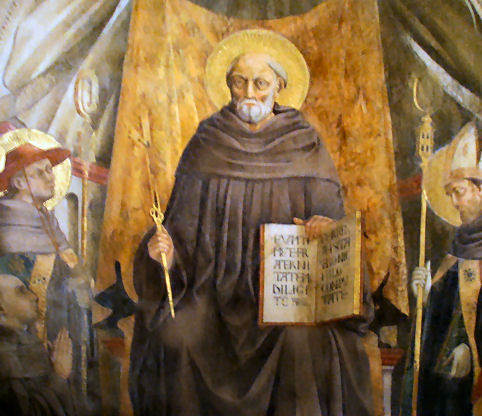
One Good Friday Giovanni Gualberto left home with his gang of roughs, fully
intending to avenge the recent murder of his brother. Upon finding the murderer,
who pleaded for his life, it being the day Jesus was crucified, Gualberto
decided to spare him, and proceeded up to San Miniato. Here the crucifix
in the middle of the church was
said to have tapped him on his head to acknowledge his mercifulness. Gualberto later became a Benedictine monk and founded the Vallombrosan
order. He died in 1073. This story is the source of Edward Burne-Jones's early painting
The Merciful Knight, which shows Christ kissing Gualberto. The
Crucifix of Saint Giovanni Gualberto, now kept in this church, is said to
be the miraculous crucifix, but it isn't that old - the story is around
200 years older than this crucifix. A cult
flourished in the late-14th and 15th centuries which ascribed to it
miraculous powers.
Opening times
Daily 8.00-12.00, 4.00-6.00
Sundays and holidays: 8.00 -10.45, 4.00 - 6.00
|
|
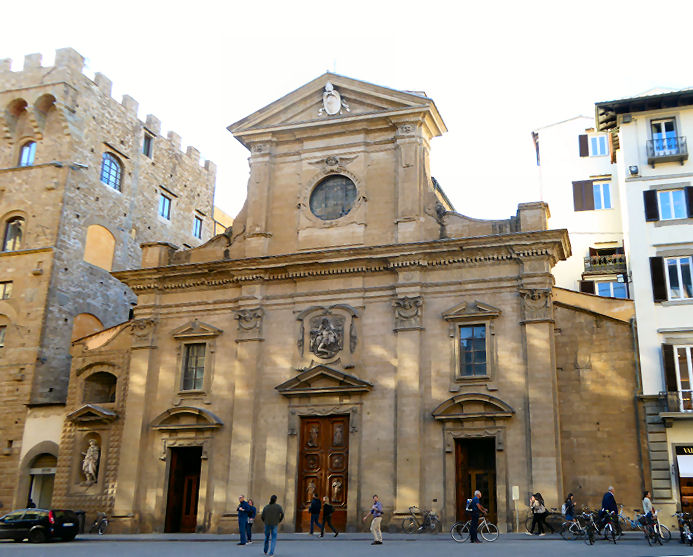
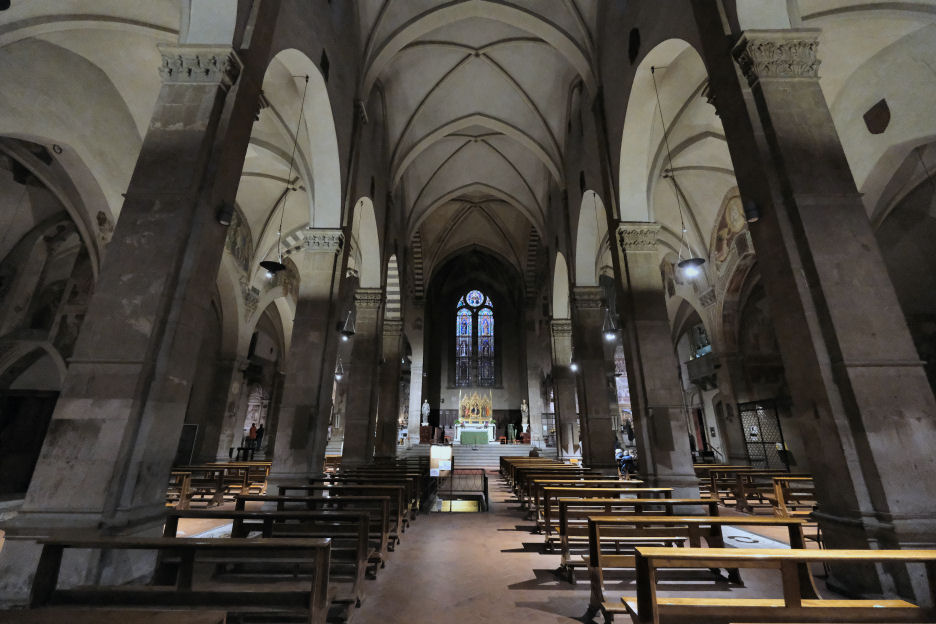
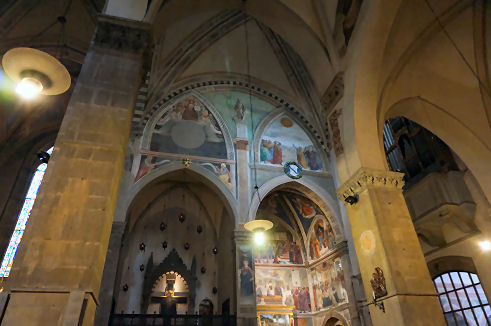
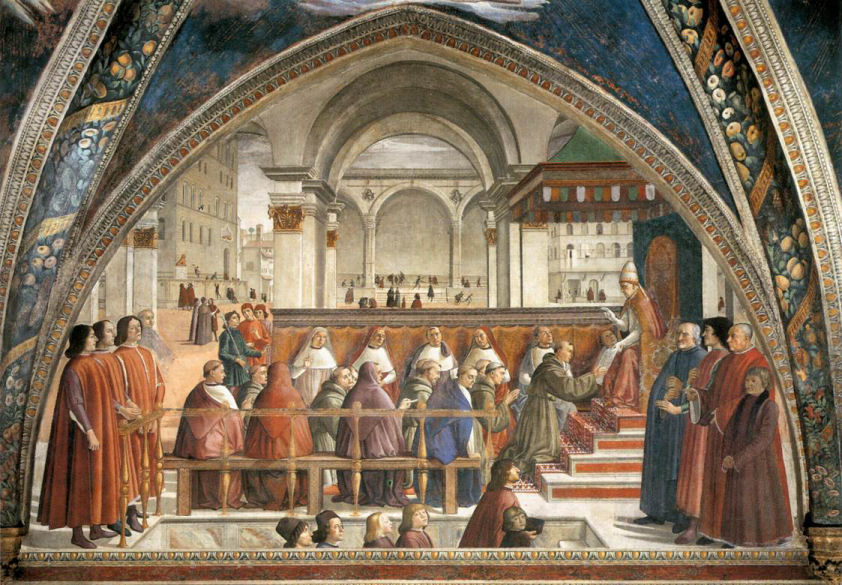
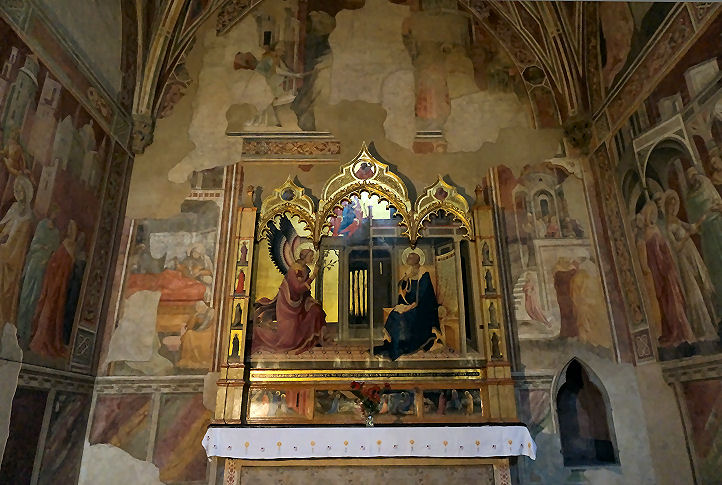
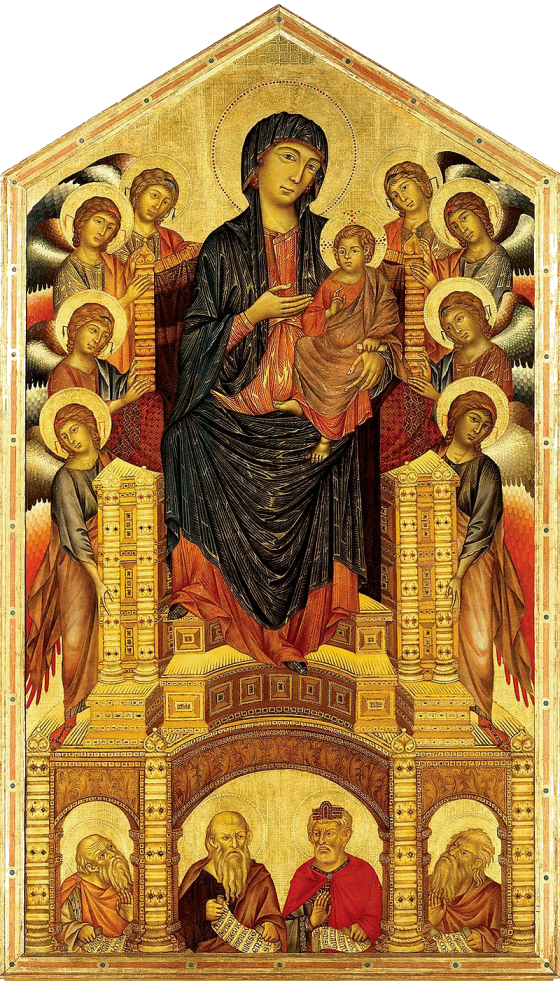
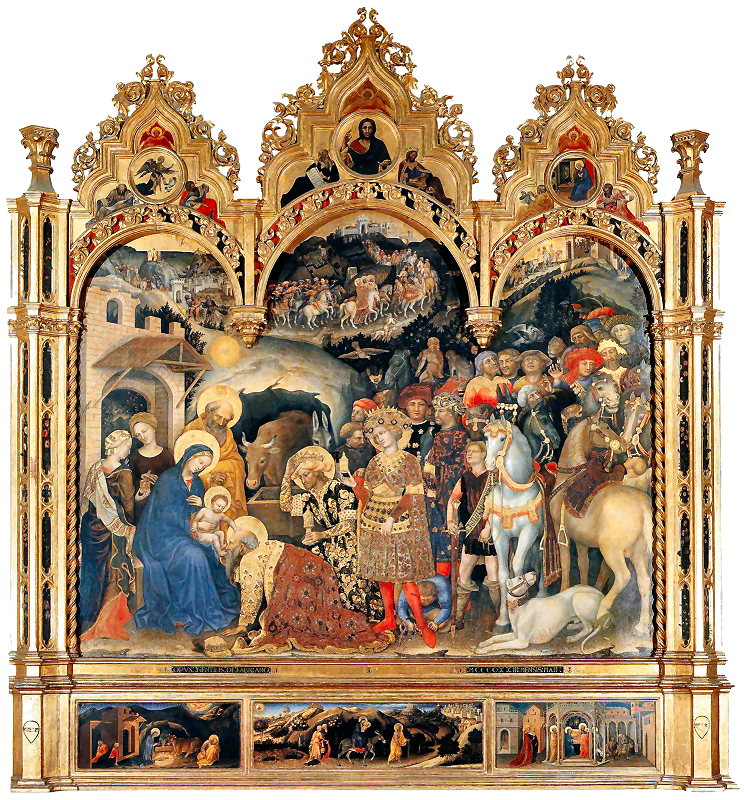
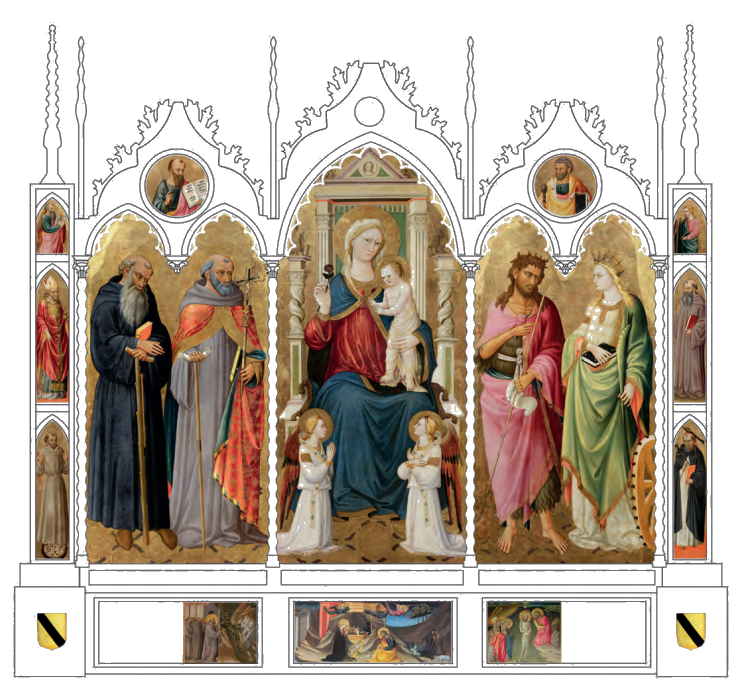
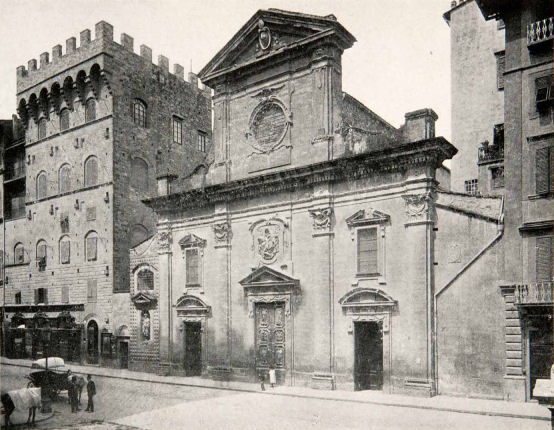
|